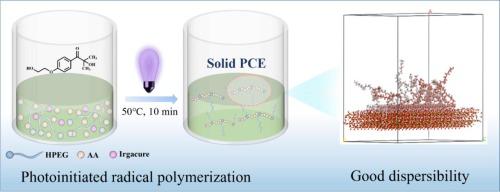通过光引发自由基聚合快速合成固体聚羧酸盐超塑化剂
IF 5.8
2区 化学
Q1 POLYMER SCIENCE
引用次数: 0
摘要
固体聚羧酸盐超塑化剂(PCE)的合成和性能优化是一项重大挑战。在我们的研究中,采用光引发自由基聚合法快速合成了固体聚羧酸盐超塑化剂(IPCE10)。IPCE10 在混凝土中表现出良好的分散性和抗压强度。动态光散射测试和分子动力学模拟表明,IPCE10 在硅酸钙水合物表面的吸附构象相对分散,吸附层较厚。这表明 IPCE10 具有更强的立体阻碍,因而分散性更好。此外,密度泛函理论计算了光引发单体和偶氮引发单体生成自由基的反应能垒,发现光引发体系的能垒明显低于偶氮引发体系,表明光引发聚合更可行。本研究提出了一种简单、快速制备固体聚羧酸盐超塑化剂的方法,为开发高附加值建筑材料提供了宝贵的启示。本文章由计算机程序翻译,如有差异,请以英文原文为准。

Rapid synthesis of solid polycarboxylate superplasticizers via photoinitiated radical polymerization
The synthesis and performance optimization of solid polycarboxylate superplasticizers (PCEs) present significant challenges. In our study, a rapid synthesis of a solid polycarboxylate superplasticizer (IPCE10) was achieved using photoinitiated free radical polymerization. IPCE10 exhibited good dispersibility and improved compressive strength in concrete. Dynamic light scattering tests and molecular dynamics simulations demonstrated that the adsorption conformation of IPCE10 on the calcium silicate hydrate surface was relatively dispersed, with a thicker adsorption layer. This indicates that IPCE10 has stronger steric hindrance, resulting in superior dispersibility. Additionally, density functional theory calculations of the reaction energy barriers for radical generation by photoinitiated and azo-initiated monomers revealed that the energy barrier in the photoinitiated system was significantly lower than that in the azo-initiated system, indicating that photoinitiated polymerization is more feasible. This study proposes a simple and rapid method for the preparation of solid polycarboxylate superplasticizers, providing valuable insights for the development of high-value-added construction materials.
求助全文
通过发布文献求助,成功后即可免费获取论文全文。
去求助
来源期刊

European Polymer Journal
化学-高分子科学
CiteScore
9.90
自引率
10.00%
发文量
691
审稿时长
23 days
期刊介绍:
European Polymer Journal is dedicated to publishing work on fundamental and applied polymer chemistry and macromolecular materials. The journal covers all aspects of polymer synthesis, including polymerization mechanisms and chemical functional transformations, with a focus on novel polymers and the relationships between molecular structure and polymer properties. In addition, we welcome submissions on bio-based or renewable polymers, stimuli-responsive systems and polymer bio-hybrids. European Polymer Journal also publishes research on the biomedical application of polymers, including drug delivery and regenerative medicine. The main scope is covered but not limited to the following core research areas:
Polymer synthesis and functionalization
• Novel synthetic routes for polymerization, functional modification, controlled/living polymerization and precision polymers.
Stimuli-responsive polymers
• Including shape memory and self-healing polymers.
Supramolecular polymers and self-assembly
• Molecular recognition and higher order polymer structures.
Renewable and sustainable polymers
• Bio-based, biodegradable and anti-microbial polymers and polymeric bio-nanocomposites.
Polymers at interfaces and surfaces
• Chemistry and engineering of surfaces with biological relevance, including patterning, antifouling polymers and polymers for membrane applications.
Biomedical applications and nanomedicine
• Polymers for regenerative medicine, drug delivery molecular release and gene therapy
The scope of European Polymer Journal no longer includes Polymer Physics.
 求助内容:
求助内容: 应助结果提醒方式:
应助结果提醒方式:


